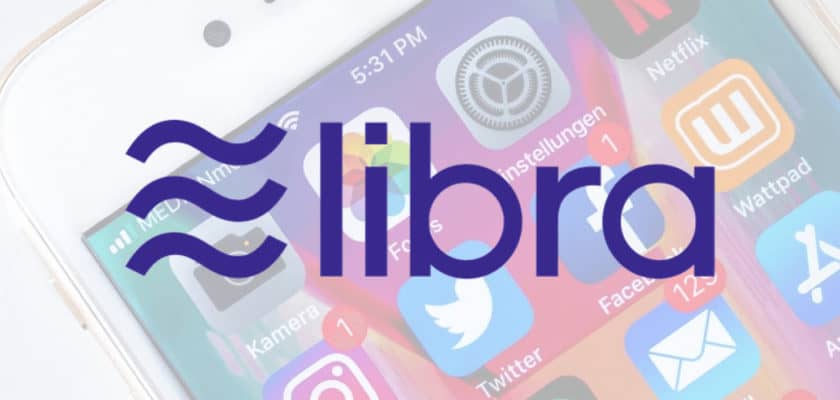Proclaimed as a new and secure way to send funds around the world, the Facebook cryptocurrency known as Libra is far from another Bitcoin. But how does Libra work, what is Facebook’s role in it, and when will it hit the market?
What Is Libra, Anyway?
Libra is a cryptocurrency that permits sending and receiving funds across the globe through a secure blockchain. Per its own definition, Libra is a “stable global cryptocurrency.”
Is Libra a Stablecoin?
A stablecoin is a digital asset that is pegged 1 to 1 to the U.S. dollar or another fiat (government-backed currency). Prominent stablecoins include Tether (USDT), Gemini Coin, USDCoin (USDC) and others.
The point of a stablecoin is to function as a digital asset while mitigating risk. For example, an investor could convert Bitcoin (BTC) into Tether (USDT) if anxious about the price of Bitcoin without incurring the transaction fees of converting back into USD.
Libra isn’t technically pegged to one cryptocurrency. Instead, it’s linked to a group of assets including government securities and bank deposits. The Libra Reserve does help keep its value stable, however.
What Will It Do?
Per the cryptocurrency’s whitepaper, “Libra’s mission is to enable a simple global currency and financial infrastructure that empowers billions of people.”
The whitepaper cites several of blockchain’s attributes as a way to combat the inequality of access to financial services (“All over the world, people with less money pay more for financial services”). These include:
- Distribution
- Open-access
- Security
- Trustlessness
- Cost-effectiveness
Who Controls this Crypto?
Libra is governed by the Independent Libra Association located in Geneva, Switzerland. According to the whitepaper, the Association is not-for-profit.
Its entire goal is to “coordinate and provide a framework for governance for the network and reserve and lead social impact grant-making in support of financial inclusion.”
Who Exactly Is in the Independent Libra Association?
The whitepaper states that the organization’s goal is to have 100 founding members by the beginning of 2020 for its launch. These companies range from Fortune 500 companies to academic organizations and non-profits.
Among many others, the Association currently includes:
- Mastercard
- PayPal
- Visa
- eBay
- Lyft
- Spotify AB
- Uber Technologies, Inc.
- Vodafone Group
- Coinbase, Inc.
- Andreessen Horowitz
What Will These Companies’ Roles Be?
These members will lead testing, blockchain development, and where and how other developers can build smart contracts on the platform. More significantly, they will serve as the blockchain’s nodes–at least in its initial phases.
The Libra blockchain protocol isn’t finished yet. As a result, they’ll also have to make the remaining “policy or technical decisions.” Every decision will require 2/3 of the votes, the same as a consensus protocol.
What Does It Take to Become a Founding Member?
There are three criteria:
- Come into contact with 20+ million people annually
- Customer balances of $500 million USD or market value of $1 billion USD
- Be among the top 100 companies in the world within an industry (per a list such as Fortune 500)
Separate criteria also apply for cryptocurrency and blockchain companies and social impact partners.
What Is Facebook’s Role In Libra?
Long-hailed as Facebook’s cryptocurrency, the company’s role in the crypto is, by their own reports, not that of a sole controller. The whitepaper specifies that Facebook was crucial in developing the blockchain, creating the Association, and founding a subsidiary to control the network’s services.
This subsidiary, known as Calibra, was created “to ensure separation between social and financial data and to build and operate services on its behalf on top of the Libra network.”
How exactly this separation will be maintained is not specified.
Within the Association, Facebook will have the same amount of authority as the other founding members, though Facebook will retain a management position through 2019
What Does Libra’s Blockchain Look Like?
Libra’s blockchain is a little different than the average distributed ledger. For starters, there is some concern that the cryptocurrency is not, in fact, a cryptocurrency because it doesn’t not exist on a “block” chain.
“Unlike previous blockchains, which view the blockchain as a collection of blocks of transactions, the Libra Blockchain is a single data structure that records the history of transactions and states over time.”
The reasoning for this is that it “simplifies the work of applications accessing the blockchain.” However, it also raises questions on what information will be private.
But like Bitcoin, Libra’s blockchain will be pseudonymous, meaning that users can have multiple wallets.
Will the Libra Blockchain Be Decentralized?
Whether or not this cryptocurrency is decentralized is up for debate. Upon its first release, Libra will not be a permissionless blockchain. In other words, you require permission from the network to run a node.
They state their reasoning as the following:
We do not believe that there is a proven solution that can deliver the scale, stability, and security needed to support billions of people and transactions across the globe through a permissionless network
However, a permissionless and truly decentralized blockchain is the goal within five years.
When Will Libra be Available?
Libra is projected to become available in the first half of 2020. Facebook is planning on integrating the cryptocurrency within its products.
Concern Sparks Over Facebook’s Libra
There is, by Facebook and the Association’s own estimates, a lot left to be done before Libra becomes available. In the meantime, there is concern over perceived ambiguity within the whitepaper, the blockchain’s lack of decentralization, and what connecting transactions within a social media platform would do.

